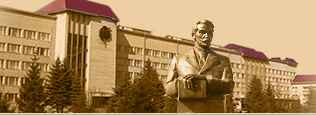AGROECOLOGICAL CONDITION OF THE GROUND COVER OF THE REFERENCE DRYING SYSTEMS IN THE PRIPYAT DRAINAGE AREA.
The results of agrochemical description of soils are revealed and the water-physical indexes of the dried soils of the standard systems are considered in the article. Every system had monitoring points and corresponding numeration: 1 – Kopaivska; 2 – Verkhnyo-Prypjatska; 3 – Tsyrska; 4 – Korostynska; 5 – Gorkivska drying systems. Patterns are taken mainly in peat soils, and also in hydromorphic mineral soils, in order to compare and to develop the criteria of the geoinformational providing and estimation of the agroecological condition of the drying systems. The results of analyses reveal that in the last few years was considerable falling of fertility of peat and mineral dried soils. The peat arreys deserve the special attention among the considered earth because of the potential fertility and productivity that can give the considerable harvests of agricultures. Moreover, peat bogs are important for adjusting of superficial flow and forming of supply of underwaters. The excessive or clumsy drainage results in serious violations of the water mode and irreversible losses of potential fertility. Development of certain projects guarding of the dried soils and choice of directions of their use requires investigations of optimization of directions of soil forming processes, estimation and prognosis of the agro ecological state of environment. It is set as a result of researches, that in the dried peat soils the processes of mineralization occur very actively, and that is why the important task of mastering of these arrays under agricultural cultures is adjusting of supplies of organic substance, rates of it mineralization by the bilateral adjusting of the water-air mode and by the choice of optimal structure of sowing areas. If not to stop the process of intensive mineralization of peat, then the peatbog of middle power (1 m) is mineralized in 50–60 years. The results of analyses reveal that in the last few years took place considerable falling of fertility peat and mineral dried soils. Content of movable phosphorus in peat soils is within the limits of a 10,5–26,0 mg per 100 g of soil, exchange potassium 13,0–25,0 mgs per 100 g of soil that corresponds subzero material well-being, optimal content of P2O5 and K2O 30–40 mgs per 100 g of soil corresponds for most agricultural cultures. Content of movable forms of phosphorus and potassium in the mineral dried soils does not exceed phosphorus are 18,2 mgs per 100 g and to potassium are 6,4 mgs per 100 g. The reaction of the ground solution has an interval 4,9–5,4 units in peat and 5,1–5,2 ones in mineral soils, that testifies to the processes of decalcification of these soils and lack of calcium and magnesium for optimal occuring of metabolism of plants.
Key words: drying system, reference system, dried soils, soil forming processes, harmonious exploitation, agrochemical description, shrinkage of peat, mineralization, monitoring.
References:
- Bambalov N. N. Rol` bolot v by`osfere / N. Bambalov, V. A. Rakovy`ch. – My`nsk: Bel. nauka, 2005. – 285 s.
- Voznyuk S. T. Perezvolozheni grunty` ta yix melioraciya / T. Voznyuk [ta in.]. – K.: Urozhaj, 1984. – 104 s.
- Gordy`jchuk A. S. Vly`yany`e sel`skoxozyajstvennogo y`spol`zovany`ya y` uvlazhneny`ya na srabotku glubokozalezhnыx torfyany`kov v Poles`e USSR / S. Gordy`jchuk // Pochvovedeny`e. – 1978. – # 11. – S. 103–108.
- Evdoky`mova N. V. Ob osadke y` by`oxy`my`cheskoj srabotke torfa v Poles`e USSR / V. Evdoky`mova, M. N. Mostovyj, E. Y`. Malyj // Pochvovedeny`e. – 1976. – # 6. – S. 126–128.
- Zajko S. M. Evolyucy`ya pochv mely`ory`rovannyx terry`tory`j Belorussy`y` / M. Zajko, L. F. Vashkevy`ch, L. Ya. Svy`rnovsky`j. – My`nsk : Uny`versy`tetskoe, 1990. – 288 s.
- Koloshko L. K. Agroekologichny`j stan gruntiv, pry`chy`ny` i naslidky` yix degradaciyi u basejni r. Pry`p’yat` / K. Koloshko, L. F. Bondarchuk // Materialy` nauk. konf. “Ekologo-ekonomichni problemy` APK”. – L., 2002. – T. 1. – S. 56–63.
- Murashko A. Y`. Soxraneny`e pochv / Y`. Murashko, E. A. Stel`mashok, V. V. Zhy`lko. – My`nsk : Uradzhaj, 1989. – 232 s
- Polyans`ky`j S. V. Ekologichni problemy` meliorovany`x agrolandshaftiv Zaxidnogo polissya / V. Polyans`ky`j // Visny`k Nacional`nogo universy`tetu vodnogo gospodarstva ta pry`rodokory`stuvannya. Zbirny`k naukovy`x pracz`. Sil`s`kogospodars`ki nauky`. – Rivne: NUVGP. – 2014. – # 4 (64). – S. 43–53.
- Polyans`ky`j S. V. Konstrukty`vno-geografichny`j analiz ta ocinka stanu meliorovany`x agrolandshaftiv Voly`ns`koyi oblasti: dy`s. kand. geogr. nauk : 11.00.11 / V. Polyans`ky`j; Sxidnoyevropejs`ky`j nacz. un-t im. Lesi Ukrayinky`. – Lucz`k, 2013. – 240 s
- Skoropanov S. G. Problemy by`oxy`my`y` organy`cheskogo veshhestva torfyanyx pochv / G. Skoropanov, Y`. Y`. Ly`shtvan, N. N. Bambalov // Problemy pochvovedeny`ya. – M. : Nauka, 1982. – S. 41–45.
- Truskavecz`ky`j R. S. Torfovi g`runty` i torfovy`shha Ukrayiny` / Nacz. nauk. centr “Insty`tut g`runtoznavstva ta agroximiyi im. O. N. Sokolovs`kogo”; R. S. Truskavecz`ky`j. – Xarkiv : Mis`kdruk, 2010. – 278 s.
- Fesyuk V. O. Ekologichny`j stan osushuval`ny`x sy`stem doly`ny` r. Pry`p’yat` / O. Fesyuk, S. V. Polyans`ky`j // Gidrologiya, gidroximiya, gidroekologiya : nauk. zb. – K., 2010. – T. 2. – S. 199–209.
- Fondovi materialy` po obstezhennyu osushuval`ny`x sy`stem Voly`ns`kogo filialu Insty`tutu “Ukrdiprovodgosp” i Voly`ns`kogo “Oblvodgospu”. – 2002.
